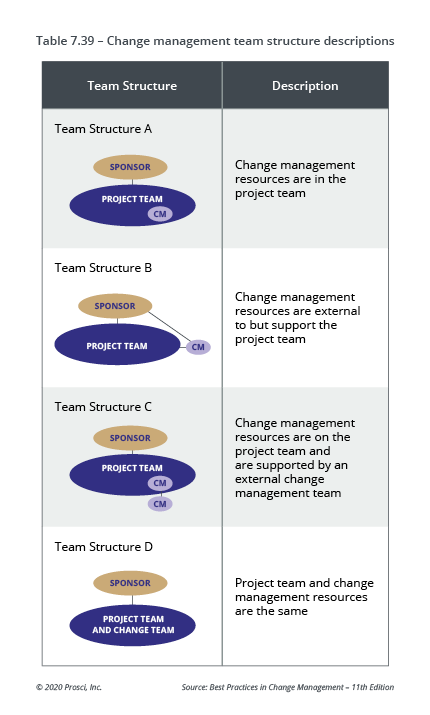Tips to Help Plan for the People Side of Change

4 Mins
Updated: November 18, 2025
Published: July 27, 2015

It is a fairly common question - which changes need a plan for change management? Or, more directly, I have a pretty small change, do I really need a change management plan? While the change management effort will certainly be customized and tailored to your particular change effort, a change management plan is a critical component of any change effort, regardless of the size. The more appropriate and important question is: does your change effort require people to do things differently? If the answer is yes, then the value your change delivers will be tied directly to how employees adopt and embrace the change - and a change management plan should be developed.
Prosci's methodology uses two assessments in the preparing for change phase - one for evaluating the nature of the change including how big and how disruptive it is (the Change Characteristics Assessment) and a second for evaluating the groups being impacted by the change and their propensity to support or resist the change (the Organizational Attributes Assessment). The result of these two assessments tells you how big of a risk the change effort faces and how much change management is needed. But, if your effort requires people to change how they do their work you need a change management plan.
Common "plan-less" approaches
There are really three main culprits when it comes to project teams attempting to introduce change without a structured approach and plan for the people side.
- Culprit #1 - "We have a communication plan, isn't that all we need?"
- Culprit #2 - "We are sending them to training, isn't that enough?"
- Culprit #3 - "Can't we just tell people to do it?"
The first two instances represent a limited view of what change management really means. For years, organizations have had "communications" and "training" departments. So without a structured methodology for managing the people side of change, it is easy to assume that communication or training is enough. However, best practices data on the people side of change shows that there are many other organizational levers that can be used to drive successful change - specifically the actions of the change sponsor and the coaching provided by managers and supervisors. Without a robust change management plan, teams will revert to the usual suspects of communication and training as the only vehicles to support the people side of the change.
The third culprit results from the belief by some project teams and leaders that employees can simply be told to change and they will. There are numerous reasons why this approach is destined to fail - particularly recent efforts to empower workforces and new values of accountability and ownership (replacing predictability and control). Employees who are engaged ask more than just "how high" when they are told to jump. Their first response is often "why?" Simply telling people to change, rather than managing the change with a structured plan, results in greater productivity declines, more resistance and in some cases complete project failure.
Tactics for neutralizing the "plan-less" approach
Moving from ad hoc to competent; following a structured approach
The first tactic here is to adopt a structured approach to the people side of change. Many participants in Prosci's certification program walk away happily surprised by the fact that they now have a process to follow for managing the people side of change. Although sometimes considered the "soft" side of change, managing the people side of change is many times more difficult and complex than the technical components of the change - it is actually the "harder" side of the change. But successful change can be modeled and repeated by following a structured approach.
Benchmarking data suggests that more and more teams are utilizing a structured approach for change management. In Prosci's 2003 benchmarking study, only 34% of participants reported that the followed a structured approach for the people side of change. In the 2007 study, that number rose to 58%. Preliminary results from Prosci's 2009 benchmarking study indicate the number is moving closer to 65%. This jump is reflective of 1) more changes failing because the people side was ignored and 2) more project teams dedicating the mindshare and resources for the people elements.
During this same time, more and more teams are attributing the success of their projects to using a structured approach. In each study, participants are asked what the number one contributor to success was on their project. In each study, the role of the sponsor was number one. However, a structured approach has moved from #5 on the list in 2003 to #2 in 2015.
A structured approach to change management provides purpose and direction to the people side activities. It ensures that all organizational change management tools are used, that all actors are engaged, and that the change management effort matches the change management needs.
Removing complexity; selecting an approach that is easy-to-use
While building commitment and managing resistance can be difficult, the most effective approaches to change management are simple, easy-to-use and intuitive. By a large margin, participants in the 2007 benchmarking study identified "easy-to-use" as the top selection criteria for their methodology. Easy-to-use was further defined as: easy to implement, easy to understand, easy to communicate to others, simple, practical, structured and systematic, logical, comprehensive and holistic.
One of the main reasons a complex approach is not practical is that many people in the organization must be involved in the change management effort. Senior leaders must fulfill the role of sponsor. Managers and supervisors must fulfill the role of coach. Communication, Training, Organizational Development and Human Resource groups will all be involved. And the project team must work to integrate change management tasks into the overall project plan. A simple, easy-to-use process enables a more unified approach by all the actors involved in managing change.
The Prosci ADKAR Model provides a thread for all those involved in change management - it is simple to understand and easy to apply in both professional and private settings. Prosci's organizational change management methodology is built as a scalable process so it can be easily applied and customized to numerous types of change. In the end, for change management to take hold on a project, people must be able to see why it is important, what it means and how it can easily support the other work they are doing.
Planting the seeds in the right places; ensuring change management resources on projects
In the end, change management is applied to projects and change efforts that impact how people do their jobs. Projects must assign the financial resources, human resources and mindshare necessary for change management to be effective. The first major hurdle is building an appreciation for the need for change management with project teams and project leaders. Prosci's model for connecting change management to business results shows a simple flow that links projects to their purpose, the particulars of what is changing and the people who will ultimately be impacted. Read more about connecting change management to business results.
There are several options for resourcing change management on a particular project. At the simplest level, the change management work can either be done by someone on the project team (Structure A below) or by an outside group supporting the project (Structure B below).

Each model has pros and cons. When the change management work is done by a person on the project team, there is less work required to get the change management resource up to speed on the change details, but more work may be required on the change management expertise front. An outside group supporting a project team likely brings more experience and expertise in change management, but often lacks an understanding of the business issues behind the particular change.
Regardless of the particular structure, there must be resources dedicated to the people side of change.



